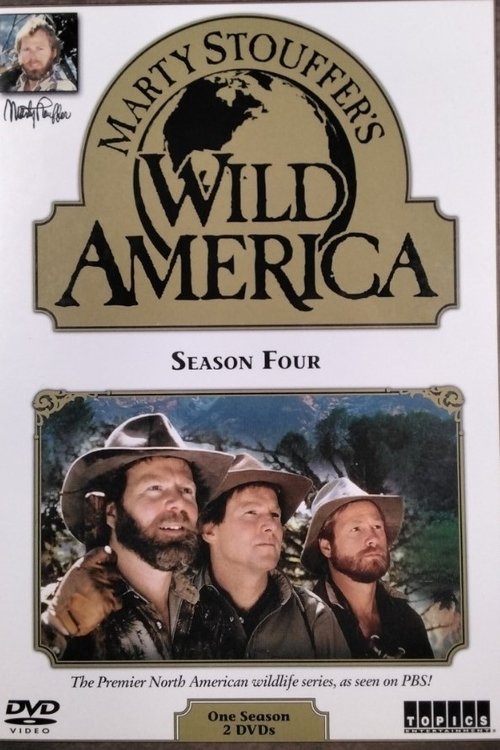
Broadcast date
06-10-1985 • 10 episodes
Season 4
Episodes of this season
1. North Woods Lynx

Elegant and graceful, the Lynx is one of Nature's finest physical specimens. Its primary quarry is the elusive Snowshoe Hare. It is seen that the numbers of predator and prey -- Lynx and Snowshoe Hare -- are intricately linked in a ten-year cycle that rises and falls in unison. This fascinating, unexplained phenomenon is only one of many mysteries in the Great North Woods.
2. Wookpeckers - Nature's Hammerheads

Have you ever walked in the woods and seen a hole high up in a tree? Chances are that even though a small mammal or another bird lives in it now, a woodpecker originally drilled it. The ancients believed these birds were gods that could bring forth rain by tapping their bills. Today, we know they can't perform miracles and when we do think of woodpeckers, the cartoon character Woody immediately comes to mind. But, age old deity or modern comic, one thing is clear, these birds know how to use their heads. Their skulls are toughened to withstand the shock of constant, forceful pounding as they whack away at wood in search for a meal or a home. Their family also includes Flickers and Sapsuckers, and totals between 23 and 45 species and sub-species, depending on who you talk to. All are adapted to a life on tree trunks and in branches. So come with me now and let's take a look at the fascinating lives of the "WOODPECKERS-NATURE'S HAMMERHEADS".
3. Designs for Defense

Wild animals have evolved a wide range of survival tactics. They must eat, and they must keep from being eaten. For predators, speed or stealth is essential, and it helps to have special equipment-sharp fangs or talons-to catch and hold prey. But nature is not all tooth and claw. Many animals have survived by being slow and steady-and by having some unique feature that protects them from enemies. Porcupines may not seem very fast or alert-but they don't need to be. For countless generations they have gone about their business secure in the instinctive knowledge that few creatures will threaten them - and those not for long. Many others have also developed strange-and remarkably successful strategies for dealing with predators. Such methods don't help the animal to gather food - but they do keep it from being fed upon. Let's take a closer look at these "DESIGNS FOR DEFENSE".
4. Cutthroat - Yellowstone Lake

Yellowstone Lake has a vast underwater wilderness never seen by the two million annual visitors to this National Park. It is also the realm of a creature that forms the cornerstone of an entire aquatic ecosystem -- the brilliant Cutthroat Trout. A summer-long exploration by Marty Stouffer and crew begins in the remote Thorofare Region, our wildest land south of Alaska.
5. Cutthroat - Yellowstone River

Dive into the underwater spawning ritual of Trout and related species. The crew's exploration takes them deeper into the northern wilderness along the magnificent Yellowstone River. At LeHardy Rapids, Marty catches slippery Cutthroat to study them face-to-face, then dives into the turbulence to hand-feed a large school of Trout with Salmonfly larvae. Back on the surface, we examine the reproductive cycle and all the other primary predators of the Salmonfly.
6. Cutthroat - Grizzly Creek

The last part of our search for the Cutthroat Trout took us to the bottom of Yellowstone Lake. Now, we follow the trout on a danger filled journey to their spawning areas, as they run the raging rapids of Yellowstone River.
7. Killer Mice

Through the night, a ravenous predator stalks its unwary prey. With a swift bite to the skull, it slays the victim, then throws back its head and howls. But this beast that hunts like a Weasel and howls like a Wolf is neither -- it's the five-inch Grasshopper Mouse of our western deserts and plains. It feasts on Tarantulas, Scorpions, and even other Rodents -- yet displays close family ties.
8. Controversial Coyote

It's easy to imagine the untamed wildness of the good old days as you listen to a lone Coyote sing its ancient song. To some of us, this mournful cry kindles delight and inspiration, to others dread and hatred. In Indian mythology, the coyote was revered for its cleverness and mystical song. Yet our modern society condemns the Coyote for its predatory instinct to kill. Regardless of our mixed emotions, this wild canine has proven itself to be one of the most intelligent and successful of all animals on earth. With efficient hunting skills and opportunistic diet, strong social bonds and an incredible capacity to learn, the coyote can quickly change habits and habitats. Even in the face of adversity, this animal thrives, the "CONTROVERSIAL COYOTE".
9. Remarkable Reptiles

Many species of Reptiles reside in the USA, their lives, their habitats, and what makes them remarkable are compared to other animals.
10. Tracking Wildlife

Catching a glimpse of a wild creature is always a thrill, but it's not always easy. For one thing, many of them are active during the night or early morning hours when most humans are asleep and for another, all wildlife is going to do its best to avoid man. But every animal, from mouse to moose, leaves behind signs of its passing. Often these traces tell a more complete and fascinating story than if all we see is a quick glimpse of the creature itself. It's like learning to read a strange kind of newspaper. In any season, and in almost any kind of terrain, clues can be found to the wildlife that inhabits an area. The more closely you look, the more you'll be able to tell what they've been up to. It doesn't take any special equipment, just a little patience, so let's go "TRACKING WILDLIFE".
Show more expand_more
keyboard_double_arrow_down
This season's cast
Show more expand_more
keyboard_double_arrow_down